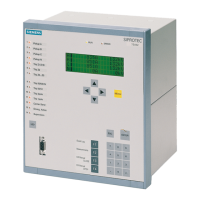Functions
2.9 Backup Time Overcurrent Protection
SIPROTEC, 7SD610, Manual
C53000-G1176-C145-6, Release date 02.2011
100
2.9 Backup Time Overcurrent Protection
The 7SD610 features a time overcurrent protection function which can be used as either a back-up or an emer-
gency overcurrent protection. All stages may be configured independently of each other and combined accord-
ing to the user's requirements.
2.9.1 General
Whereas the differential protection can only operate correctly if both devices receive the protection data of the
respective other device properly, the emergency overcurrent protection
requires only the local currents. As an
emergency overcurrent protection it automatically replaces the differential protection as short-circuit protection,
if data communication of the differential protection is faulty (emergency operation). The differential protection
is blocked as a result.
If the overcurrent protection is set as a backup overcurrent protection
, it will work independently of other pro-
tection and monitoring functions, i.e. also independently of the differential protection. The backup overcurrent
protection can also be used as sole short-circuit protection if no suitable channels for the communication
between the protection devices are available during the initial commissioning.
The overcurrent protection has directional and non-directional stages for the phase currents and for the earth
current; these are:
• two overcurrent stages with a definite time characteristic (O/C with DT),
• one directional overcurrent stage with a definite time characteristic (O/C with DT),
• A further overcurrent stage which has an additional enable input and can therefore be used as an emergen-
cy stage e.g. if the remaining stages are used as backup stages, or as a stub protection.
• One overcurrent stage with inverse time characteristic (IDMT),
• One directional overcurrent stage with a inverse time characteristic (O/C with IDMT),
These six stages are independent of each other and are freely combinable. Blocking from external criteria via
binary inputs is possible, as well as switch-onto-fault tripping. During the single-pole pause, all earth stages of
the overcurrent protection are automatically blocked.
It is also possible to release one or more of the stages in switching-onto-fault conditions. If not all stages are
required, each individual stage can be deactivated by setting the pickup threshold to ∞.
2.9.2 Function Description
Measured Values
The phase currents are fed to the device via the input transformers of the measuring input. The earth current
3·I
0
is either measured directly or calculated.
If I
4
is connected to the starpoint of the current transformer set (address 220 I4 transformer = In prot.
line, see section2.1.2 of P.System Data 1), the earth current will be directly available as measured value.
It is used considering the I4/Iph CT factor (address221).
If the ground current of own the neutral line is not connected to the fourth current input I
4
(address 220 I4
transformer cannot be parameterized to In prot. line), the device will calculate the ground current from
the phase currents. Of course, all three phase currents of three star-connected current transformers must be
available and connected.
For the directional Iph> stages, the measuring voltage used is determined by the fault condition. The selection
occurs according to the availability of the measured values listed below.

